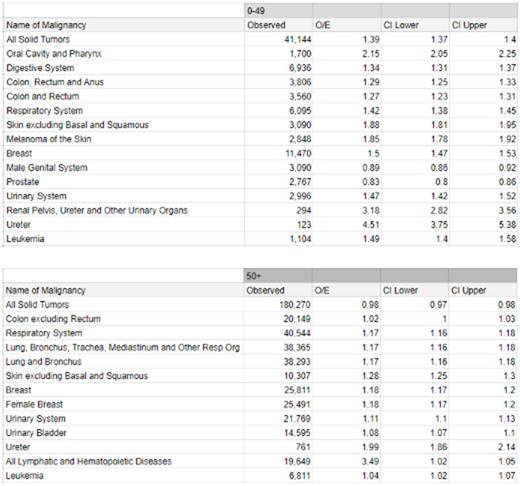Abstract
Background: Survivors of Hodgkin Lymphoma are at an increased risk of developing second malignancies because of their genetic makeup, and exposure to environmental and treatment factors. As younger patients have different risk factors relative to Hodgkin Lymphoma contrasted with those of older patients, younger and older patients might have different second malignancy risk. So, we studied the incidence rates of second malignancies, separated into two age groups (those aged below 50 and those 50 and above), in survivors of Hodgkin Lymphoma five years after the initial diagnosis. We used five years from diagnosis as cut off, as this is when most patients are released to their general practitioners. We used 50 as the cut off age for the two age cohorts as age above 50 is considered to be a high risk feature in early stage Hodgkin Lymphoma.
Methods: We analyzed the data from the Surveillance, Epidemiology and End Results (SEER) 9 database, Nov 2016 Sub {1973-2014} to determine the risk of second malignancies in five year survivors of Hodgkin Lymphoma divided into two different age cohorts. These two age cohorts included patients aged 0 to 49 when diagnosed with Hodgkin Lymphoma, and those aged 50 to 99 at diagnosis. In the age cohort of 0 to 49, there were 379,744 long term survivors who contributed 4,687,979 patient years of follow up. In the age cohort of 50 and above there were 1,263,009 patients with 9,564,271 patient years of follow up. The relative risk of subsequent malignancies is reported as the standardized incidence ratio, observed incidence [O]/expected incidence [E].
Results: After five years from diagnosis of Hodgkin Lymphoma, patients aged 0 to 49 have the highest relative risk of second malignancy of the ureter (O/E: 4.51; CI: 3.75-5.38; N=123). Patients in this age cohort saw the greatest number of cancers of the breast (O/E: 1.50; CI: 1.47-1.53; N=11,470) and an increased risk of leukemia (O/E:1.49; CI: 1.4-1.58; N=1,104). For patients aged 50 to 99 at the time of initial diagnosis, the cancer with the highest relative risk was also of the ureter (O/E: 1.99; CI: 1.86-2.14; N=761), while those with the highest absolute risk was that of the respiratory system (O/E: 1.17; CI: 1.16-1.18; N=40,544). Cancers of the respiratory system, however, are common in the general population in that age group, giving HL survivors a only slightly higher risk than the matched population. Patients of this age cohort also have a relatively high risk of cancer of the urinary system (O/E: 1.11; CI: 1.1-1.13; N=21,769). Additional malignancy risks can be found in the table below.
Conclusion: Long term survivors of Hodgkin Lymphoma have a higher risk of developing subsequent malignancies. The type of second malignancy risk is different for patients of various age groups. The information presented may help physicians in effectively monitoring long term survivors of different ages.
No relevant conflicts of interest to declare.
Author notes
Asterisk with author names denotes non-ASH members.


